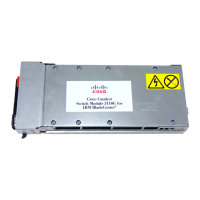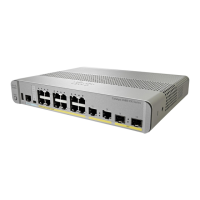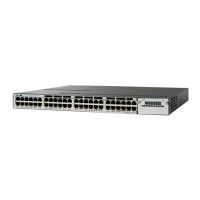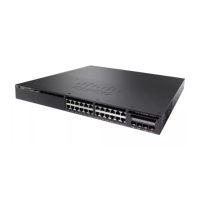1-13
Cisco Catalyst Blade Switch 3120 for HP Software Configuration Guide
OL-12247-01
Chapter 1 Overview
Default Settings After Initial Switch Configuration
• Time Domain Reflector (TDR) to diagnose and resolve cabling problems on 10/100 and
10/100/1000 copper Ethernet ports
• SFP module diagnostic management interface to monitor physical or operational status of an SFP
module
• Online diagnostics to test the hardware functionality of the supervisor engine, modules, and switch
while the switch is connected to a live network
• On-board failure logging (OBFL) to collect information about the switch and the power supplies
connected to it
• Enhanced object tracking (EOT) for HSRP to determine the proportion of hosts in a LAN by tracking
the routing table state or to trigger the standby router failover
• IP Service Level Agreements (IP SLAs) support to measure network performance by using active
traffic monitoring
• IP SLAs EOT to use the output from IP SLAs tracking operations triggered by an action such as
latency, jitter, or packet loss for a standby router failover takeover
• Embedded event manager (EEM) for device and system management to monitor key system events
and then act on them though a policy
Default Settings After Initial Switch Configuration
The switch is designed for plug-and-play operation, requiring only that you assign basic IP information
to the switch and connect it to the other devices in your network. If you have specific network needs,
you can change the interface-specific and system- and stack-wide settings.
Note For information about assigning an IP address by using the browser-based Express Setup program, see
the getting started guide. For information about assigning an IP address by using the CLI-based setup
program, see the hardware installation guide.
If you do not configure the switch at all, the switch operates with these default settings:
• Default switch IP address, subnet mask, and default gateway is 0.0.0.0. For more information, see
Chapter 3, “Assigning the Switch IP Address and Default Gateway,” and Chapter 21, “Configuring
DHCP Features and IP Source Guard.”
• Default domain name is not configured. For more information, see Chapter 3, “Assigning the Switch
IP Address and Default Gateway.”
• DHCP client is enabled, the DHCP server is enabled (only if the device acting as a DHCP server is
configured and is enabled), and the DHCP relay agent is enabled (only if the device is acting as a
DHCP relay agent is configured and is enabled). For more information, see Chapter 3, “Assigning
the Switch IP Address and Default Gateway,” and Chapter 21, “Configuring DHCP Features and IP
Source Guard.”
• Switch stack is enabled (not configurable). For more information, see Chapter 5, “Managing Switch
Stacks.”
• No passwords are defined. For more information, see Chapter 6, “Administering the Switch.”
• System name and prompt is Switch. For more information, see Chapter 6, “Administering the
Switch.”
• NTP is enabled. For more information, see Chapter 6, “Administering the Switch.”
